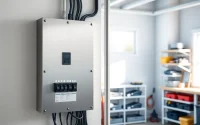Elevate Your Home with Stunning Vertikale Gärten: A Comprehensive Guide
Understanding Vertikale Gärten: The Basics
What Are Vertikale Gärten?
Vertical gardens, known in German as vertikale Gärten, are an innovative method of growing plants in a vertical space rather than traditional horizontal soil beds. These gardens utilize various structures to support the plant life and can be indoor or outdoor installations. The concept of vertical gardening capitalizes on limited space, allowing urban dwellers and gardeners with restricted areas to incorporate greenery into their environments creatively.
Benefits of Vertikale Gärten for Your Home
Implementing vertical gardens comes with numerous advantages:
- Space Efficiency: Vertical gardens allow you to utilize vertical space, making them perfect for urban living where square footage is limited.
- Aesthetic Appeal: A well-designed vertical garden can serve as an eye-catching feature in your home, enhancing its beauty and value.
- Improved Air Quality: Plants absorb carbon dioxide and release oxygen, thus helping purify indoor air.
- Noise Reduction: The foliage of vertical gardens can help mitigate noise pollution, creating a more peaceful environment.
- Food Production: They enable the growing of herbs, vegetables, and fruits, providing fresh produce right at home.
Common Types of Vertical Gardens
There are various methods and designs for vertical gardening:
- Living Walls: Also known as green walls, they consist of a structural support system, a growing medium, and irrigation methods.
- Vertical Planter Boxes: These are stacked containers or wall-mounted boxes suitable for smaller spaces, typically used for herbs and flowers.
- Grid Systems: Utilizing a grid or trellis, plants can grow upwards while supported against a wall or on a structure.
- Pocket Planting: Fabric pockets are attached to a frame or wall, providing space for plants to grow while keeping them accessible and visible.
Designing Your Vertical Garden Space
Choosing the Right Location for Vertikale Gärten
Location is crucial for the success of a vertical garden. Consider the following factors:
- Light Conditions: Choose a location that gets adequate sunlight for the type of plants you intend to grow. South-facing walls generally receive the most light.
- Accessibility: Ensure the garden is easy to reach for maintenance, watering, and harvesting, especially if growing edible plants.
- Protection from Elements: If your garden is outdoors, consider how it will be shielded from harsh weather conditions like strong winds or heavy rains.
Essential Tools and Materials
Successful installation and maintenance of vertical gardens require specific tools and materials:
- Supporting Structure: Choose between trellises, wall-mounted planters, or prefabricated living wall systems.
- Growing Medium: Depending on the design, you may need soilless mixes or soil that retains moisture.
- Irrigation System: Drip irrigation or self-watering systems can help maintain appropriate moisture levels.
- Hand Tools: Essential gardening tools include scissors, trowels, and gloves for plant handling and maintenance.
Plant Selection Strategies for Vertical Gardens
Selecting the right plants is fundamental to the success of your vertical garden. Consider the following strategies:
- Climate Adaptability: Choose plants that are suited to your local climate and the specific environment of your vertical garden.
- Growth Habits: Opt for climbing plants like vines or cascading plants such as strawberries and ferns that thrive in vertical settings.
- Color and Texture: Include a mix of foliage colors and textures to create visual interest and a cohesive design.
- Companion Planting: Utilize harmonious plant combinations that complement each other in growth and care needs.
Installation Tips for Successful Vertikale Gärten
Step-by-Step Guide to Vertical Garden Installation
Follow these steps to successfully install your vertical garden:
- Choose your location based on lighting and accessibility.
- Select your supporting structure and gather the necessary materials.
- Prepare the wall or space by cleaning it and ensuring it can support the weight of the plants and structure.
- Install your support system according to the manufacturer’s guidelines, ensuring it is securely anchored.
- Fill your planting containers or pockets with the chosen growing medium.
- Add your selected plants, ensuring they are correctly spaced to allow for growth.
- Set up an irrigation system, if applicable, and water the plants adequately.
- Monitor the garden regularly, adjusting maintenance routines as necessary to ensure optimal health.
Common Mistakes to Avoid When Setting Up
To ensure the success of your vertical garden, avoid these common pitfalls:
- Ignoring Water Needs: Over or under-watering can lead to plant stress. Monitor soil moisture and adjust accordingly.
- Poor Plant Selection: Choose plants that are appropriate for your garden’s environment and sunlight conditions.
- Neglecting Maintenance: Regularly prune, harvest, and check for pests to keep your garden in optimal shape.
- Insufficient Support: Ensure your structure is strong enough to handle the weight of fully grown plants to avoid collapses.
Maintenance Best Practices for Longevity
Ensuring the longevity of your vertical garden involves routine care:
- Regular Watering: Check the moisture levels frequently, and water as needed to prevent dehydration.
- Fertilization: Use a balanced, water-soluble fertilizer to promote healthy growth of your plants.
- Pest Control: Monitor for signs of pests and employ natural pest management strategies to protect your plants.
- Seasonal Updates: Refresh your garden with seasonal plants to keep the aesthetics vibrant and appealing throughout the year.
Innovative Ideas for Your Vertical Garden
Creative Plant Arrangements for Aesthetic Appeal
Enhance the visual impact of your vertical garden with creative arrangements:
- Layering: Use plants of varying heights to create a tiered effect that makes for a striking display.
- Color Coordination: Choose plants with complementary colors to create visual harmony in your design.
- Themed Gardens: Consider a specific theme such as a herb garden, succulent collection, or flowering landscape for coherent aesthetics.
Utilizing Technology in Vertikale Gärten
Integrating technology can augment the growth and maintenance of vertical gardens:
- Smart Irrigation Systems: Automated systems can enable precise watering schedules and moisture management, reducing manual effort.
- Sensors: Use soil moisture sensors to trigger alerts for watering needs, helping maintain plant health optimally.
- Grow Lights: For indoor vertical gardens or shaded areas, LED grow lights can supplement natural light and promote plant growth.
Incorporating DIY Elements into Your Design
Personalize your vertical garden with DIY features:
- Recycled Materials: Utilize pallets, old wooden crates, or even plastic bottles to construct your vertical garden efficiently and economically.
- Unique Planters: Experiment with handmade planters or hanging pots to add a unique touch to your design.
- Signage: Create labels for your plants using creative materials to enhance the personal touch and educate others about your garden.
Impact of Vertikale Gärten on Wellbeing and Environment
How Vertikale Gärten Improve Air Quality
Vertical gardens contribute significantly to improving air quality in urban environments:
- Carbon Dioxide Absorption: Plants absorb CO2 from the atmosphere, helping to reduce greenhouse gas levels.
- Particulate Filtration: Foliage can collect dust, pollen, and other particulates, improving ambient air quality.
- Humidity Regulation: Transpiration from plants contributes to increased moisture in the air, enhancing comfort levels.
Benefits for Mental Wellbeing and Stress Reduction
The presence of plants and greenery has a profound effect on mental health:
- Stress Reduction: Studies show that green environments can lower stress levels and promote relaxation.
- Enhanced Focus: Access to nature can improve concentration, making gardens ideal for both homes and offices.
- Therapeutic Activity: Gardening itself can be a mindful, enjoyable activity that promotes physical movement and mental engagement.
Case Studies: Successful Vertical Gardens
Several notable vertical gardens worldwide demonstrate the transformative power of this gardening method:
- The Green Wall at One Central Park, Sydney: This iconic vertical garden transforms the urban landscape with its stunning visual appeal and extensive greenery.
- Vertical Garden in Milan, Italy: Featuring two residential towers adorned with over 9,000 trees and plants, this project aims to yield benefits for air quality and aesthetics.
- L.A. Living Wall Project: Aimed at combining urban beauty with ecological benefits, this initiative exemplifies community engagement, sustainability, and art in vertical gardening.


